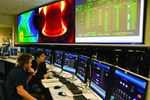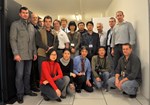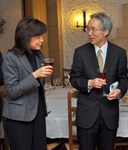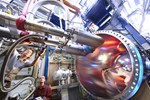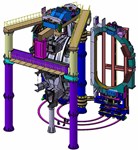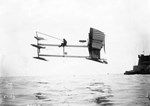In the northwest corner of MIT, away from the hustle of the campus center, a team of scientists, engineers, technicians, graduate and undergraduate students are investigating fusion, the energy of the sun and stars. The Nabisco Laboratory at the Plasma Science and Fusion Center (PSFC) is home to the Alcator C-Mod tokamak, an experiment that seeks to understand how to create a virtually endless source of energy on Earth.
Although the fusion process occurs naturally in the sun and the stars, on earth it requires unique machines, special knowledge, collaboration and a great deal of patience. A star has such a large mass that its own gravity holds its plasma together, allowing fusion reactions to continue and energy to be produced. In laboratory devices, because plasma particles will follow magnetic fields, magnets are used to hold the plasma together and away from the walls of its container, to confine it long enough for fusion to occur.
C-Mod is the third in a series of Alcator tokamaks developed at MIT since the 1960s. Characterized by a donut-shaped vacuum chamber wrapped in high-field magnets, the Alcator approach makes it possible to produce very dense and well-confined plasmas in a relatively compact device. (The name
"Alcator" comes from alto campo torus: high field torus.) This approach allowed an earlier experiment, Alcator C, to produce the first magnetically confined plasma with sufficient density and confinement to eventually achieve "breakeven." To actually realize breakeven would require higher temperatures than those reached in Alcator C.
Research on Alcator C-Mod focuses on several key issues:
Divertor Physics: Alcator C-Mod has a unique divertor system that uses specially shaped magnetic fields to "scrape'' away the cooler, outer edge of the plasma, draw it into an isolated channel on the bottom of the vacuum vessel, then pump it out of the machine. This is necessary because some ions escape from Alcator C-Mod's "magnetic bottle," and collide with the wall of the vacuum vessel, where they deposit their energy and become neutralized. Efficient divertor systems will be key elements in future fusion plants.
Plasma Control: The shape and position of the plasma is important. The edges of the plasma should be held away from the wall. Touching the wall cools the tenuous plasma and impairs the cleaning action of the divertor system. An elongated plasma shape, taller than it is wide, produces superior heating and confinement. The "Physics Operator" uses graphical computer tools to program the plasma's shape (and other parameters) before each shot. Fast feedback systems control magnet currents, gas valves, and other equipment during the shot to produce the desired results.
Radio Frequency Heating: Ions in the center of the plasma circulate around the magnetic field lines 80,000,000 times each second. When radio waves at 80 MHz, the ''ion cyclotron'' frequency, are injected into the plasma, the central ions absorb the wave energy, heating the plasma. Alcator C-Mod employs three antennae, and to date a total of five million watts of net power has been injected to heat the plasma to 80 million degrees Celsius at densities expected in ITER. The experiment seeks to discover how to optimize radio frequency heating in compact, high-field tokamaks, and to use the flexibility of this technique to study confinement and control of the plasma.
Microwave current drive: A second high-power radio wave system has been added to the C-Mod facility. Operating at higher frequency (4.6 billion cycles per second), in the microwave range, these waves couple to the hot electrons in the plasma. By launching the microwaves so that they propagate preferentially in one toroidal direction, researchers can use the power to push electrons in the direction parallel to the magnetic field, driving large electrical currents in the plasma. In this way, researchers can achieve a more favorable twist in the total magnetic field, creating conditions that can help suppress turbulence and increase confinement. This approach is also the most promising for ultimately allowing tokamaks to operate in steady state.
These areas of research, and the diagnostics used to explore them, are typical subjects of doctoral dissertations. Alcator C-Mod is one of the premier experimental facilities for training the next generation of plasma scientists. Typically there are about 30 graduate students working on Alcator C-Mod. On any given day a student could be running the experiment, collecting data and gaining new insights into plasma behavior.
Research on Alcator C-Mod contributes to an international tokamak project, being built in France: ITER. Designed to study the science of "self-sustained" (burning) plasma, ITER will be the largest tokamak ever created.
Fusion energy research at the MIT Plasma Science and Fusion Center is supported by the Office of Fusion Energy Sciences, US Department of Energy.
ITER Principal Deputy Director-General Norbert Holtkamp visited ITER-India, the Indian Domestic Agency, during 22-23 March to discuss and resolve a series of outstanding issues related to both the ITER-India procurement packages and also the ITER Project as a whole. During his visit, in addition to very fruitful discussions, he signed Procurement Arrangements for the diagnostic neutral beam worth 11.4kIUA (roughly 1kIUA, or approximately EUR 1.5 million) and the cooling water system, worth 47.25 kIUA, with Shishir Deshpande, project director of ITER-India.
The diagnostic neutral beam system will deliver a beam of neutral hydrogen atoms of 100keV energy at 20-22A of beam current into the ITER plasma to be used primarily (through charge exchange spectroscopy) for measurement of helium ash in the tokamak. It will involve extraction of an unprecedented 60A current of accelerated hydrogen ions from a radio frequency-based ion source, before they are neutralized and injected in the magnetized plasma. The beam will also be modulated at a frequency of 5Hz as diagnostic requirement and have a re-ionization loss of less than 6 precent. All these parameters demand first-of-its-kind, cutting-edge technology and R&D which is already underway.
The Indian portion of the cooling water system consists of three large subsystems—the component cooling water system, the chilled water system and the heat rejection system. The component cooling water system provides cooling water to various components of ITER, including the primary heat transfer system, at an inlet temperature of 28 °C. It transfers a total of ~1.2 GW of heat from these components to heat rejection system with a water flow rate up to ~8000 kg/s. The chilled water system will provide chilled water mainly for HVAC applications and also for cooling of some components with an inlet water temperature of 6oC and a total water flow rate of ~750kg/s. The heat rejection system is a system of large cooling towers—the final heat sink of the overall ITER plant, rejecting a total heat of up to 1.2 GW to the atmosphere.
The signature of these two Procurement Arrangements brings India's total to five. India has now signed for a total value of 123.9 kIUA out of a kitty of 244.21kIUA worth of components to be delivered to ITER. India has crossed the 50 percent mark of signed Procurement Arrangements (in value) for its deliverables to ITER.
You can talk to your colleagues over the phone and meet through videoconferencing, but nothing beats face-to-face contact. The in-person progress meeting of the IT Working Group that was organized last week at ITER provided for just that.
Thursday 25 and Friday 26 March, some 20 IT officers from the ITER Domestic Agencies gathered here at Headquarters to meet their counterparts, present their own "IT landscape" and discuss such topics as unifying communication systems, database replication or applications interconnection.
In lay language, explains IT expert Cédric Chaumette who organized the event, this translates into "gains in efficiency and reductions in cost by using the same tools throughout the ITER worldwide network."
Considering the benefits of this type of "in person" meeting, IT plans to organize one every year.
Danai Tsukhara, the recently appointed Japanese Consul General in Marseille, speaks French without the trace of an accent, not even the singsong accent of Toulouse, where he studied to become a French teacher. Life decided otherwise and he became a diplomat, posted in France, Zaïre, the United States, Senegal, Belgium and Guinea.
Last Friday, Danai Tsukhara was welcomed at ITER by Director-General Kaname Ikeda and was later given the opportunity to meet most of the Japanese staff members (29 people) for a cocktail at the Château.
The Japanese Consul General in Marseille has jurisdiction over four French regions: PACA, Languedoc-Roussillon, Midi-Pyrénées and Corsica. Some 2,400 Japanese nationals live in that area, half of them married to French citizens.
|
The designs of the ITER cryopumps and cryogenic supply systems are now accelerating towards completion. Last week a three-day preliminary design review (PDR) was held at ITER Headquarters to confirm the technical maturity of the design, prepare the manufacturing of a torus pre-production cryopump and pursue developments towards the Procurement Arrangement.
"We have to make absolutely sure that everything is going in the right direction," explains Robert Pearce, ITER Vacuum Pumping Section Leader and the organizer of the review. "It is very important, at this stage, to present the design status to a panel of distinguished independent experts that will see if there's a problem we haven't identified and come up with pertinent suggestions ..."
Wolfgang Obert, Cryogenic Group Leader at JET, who was responsible for the cutting edge design and operation of JET cryogenics system, was the review Chair. He was supported by: Hans Falter, who led the development of neutral beams at JET and IPP, Garching; Laurent Tavian, responsible for CERN's cryogenic systems; and Larry Baylor, a world expert in pellet injection development.
All together, the meeting was attended by more than 60 people from ITER, the European Domestic Agency F4E and European Associates either at Headquarters or through video conference. This PDR for the ITER cryopumps and front end cryodistribution system was one of the largest ever held at ITER.
The next big step is scheduled for the end of the year, with the call for tender for a full size pre-production torus cryopump.
More than 100,000 cables will be used in ITER for a total length of about 600 kilometres. Winding and wiggling into the innards of the Tokamak Complex they will connect components and transport power, signals and commands.
The environment in which cables will operate will be cramped and aggressive. Their organization, routing and integration require a lot of thinking and planning, especially since the installation will be in constant evolution.
Dealing with this complexity is the job of Joël Hourtoule's Steady State Electrical Network (SSEN) Section. He and his cablemen have experience in machines that resemble ITER: Joël was in charge of cable management at Tore Supra; David Beltran, ITER's newly appointed Cable Engineering Responsible Officer, comes fresh from the Spanish synchrotron CELLS and Cable Database Technical Engineer Jashwant Sonara was until recently with the Indian Steady State Superconducting Tokamak (SST-1).
ITER, however, is different, and not just because of its size and experimental nature. As components will be procured by the seven Domestic Agencies and as the installation is composed of various interacting "plant systems," the documentation issue is at the core of cable engineering's challenge.
"A nuclear operator must know his installation down to the smallest of its components," explains Joël. Descriptive documents, which safety authorities can request at any time, must be perfectly accurate and constantly updated. "This means that we must know precisely what goes into the components that are delivered through Procurement Arrangements, especially those that fall under the 'Functional Specification' category. It also means that we have to work in close collaboration with the different plant systems within ITER to centralize their data."
This will be accomplished by establishing procedures and "best practice" guidelines and by implementing tools to create and fill databases. "People in Plant Systems have experience from other installations. They know that when not properly managed a cable issue can turn into a nightmare ... and a costly one at that."
Last February, Joël and some of his colleagues, along with Central Integration & Engineering (CIE) specialists, participated in a meeting at Laser Megajoule (LMJ) near Bordeaux to discuss cable engineering strategies. The construction of the LMJ inertial fusion facility is presently at the stage where ITER will be six years from now, and there is a lot to learn from their experience.
Cable engineering in ITER is "an industrial and organizational issue, but not only," stresses Joël. "We need good will and a constant dialogue with our colleagues in the plant systems. What it comes down to in the end is that it's a human issue."
The Korean Domestic Agency (KO-DA) signed the first contract with industry for assembly tooling this week, following a call for tender launched in January.
The contract with SFA Engineering Corp covers the design of all assembly tools allocated to Korea. It also covers the manufacture of the sector sub-assembly tools, which are those required for the very first stages of ITER assembly.
SFA has been involved with the conceptual designs of the ITER assembly tools through design contracts from the KO-DA since 2005. With this latest contract, the company will move on to the next stage: design and manufacturing of the assembly tools.
In the scope of the Procurement Arrangement for assembly tooling that was signed last August between the ITER Organization and Korea, the KO-DA is responsible for procuring 122 different types of purpose-built assembly tools for ITER. These mainly motor-driven or hydraulic-powered tools are designed to accomplish specific tasks—lifting, adjusting, supporting, transporting, aligning—during assembly of the ITER Tokamak device.
"This is a very challenging procurement," says Kihak Im, Responsible Engineer for the in-kind assembly tooling at ITER. "The size and weight of the components, as well as the very tight tolerances for manoeuvring, puts this in the realm of 'never-before attempted.' In some cases, we'll be working with tolerances of 2-3 millimetres to position components that stand 20 metres high and weigh hundreds of tonnes."
The contract with SFA is for a period of 54 months. The contracts for the manufacture of the remaining assembly tools will be placed before May 2012.
Seaplanes are the dinosaurs of commercial aviation history. They once ruled the skies but became almost extinct during the course of evolution.
The first seaplane in history took off from the waters of Étang de Berre one hundred years ago, on 28 March 1910. It was a frail-looking machine equipped with a small 50 HP engine. Its designer and pilot, an engineer from Marseille named Henri Fabre, rode it astride, as if riding a winged horse.
Pegasus, however, was not the name Henri Fabre chose for his "hydro-aeroplane." The 27-year old engineer preferred to name his invention Le Canard (The Duck).
On that first flight, Le Canard flew a distance of about 500 metres, twice as far as the Wright brothers' aeroplane seven years earlier at Kitty Hawk, North Carolina. On the same day, Fabre, who had never flown before, not even as a passenger, performed five other flights and made an elegant landing—or "alighting" which is more proper for seaplanes—in the Martigues marina.
Henri Fabre, whose feat will be celebrated throughout the region this week-end, opened the way for long-distance commercial flight. A good decade before regular aircrafts, seaplanes were to venture across the transatlantic route.
Unaware that it was paying homage to Henri Fabre, Pan American Airlines opened the world's first transatlantic passenger service in 1939, between New York and Marseille. And just as Le Canard had done 29 years earlier, the fabled Yankee Clipper, Boeing's 74-passenger luxury "flying boat", would land on and take off from the waters of Étang de Berre.
|



